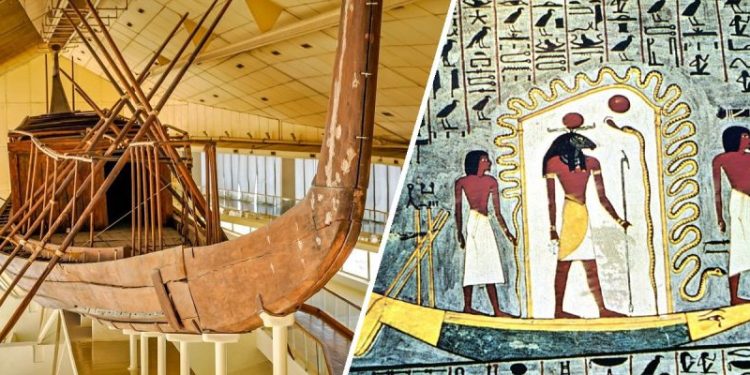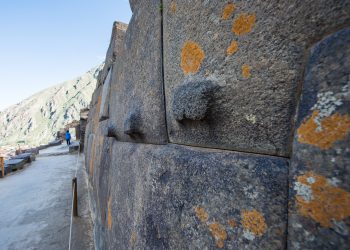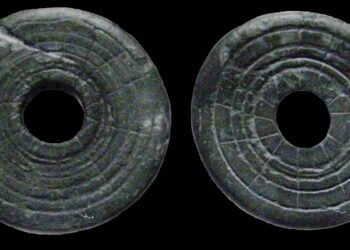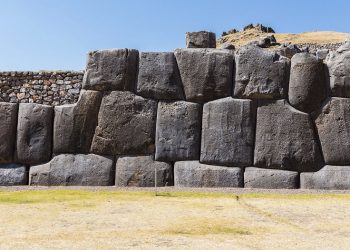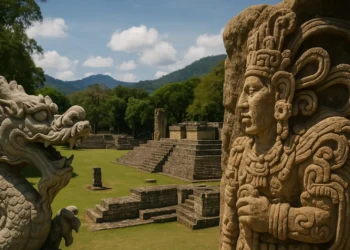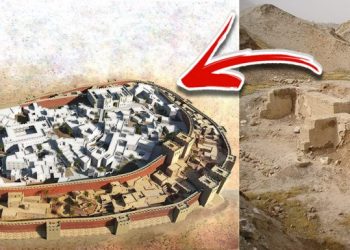For ancient Egyptians, the perpetual cycle of the coming and setting of the Sun is comparable to the cycle of life and death.
Thus, each morning the Sun rises in the East, rises to the zenith, ages towards the West, and then disappears into the realm of the dead, the Duat.
The solar god Ra makes this diurnal journey aboard a boat called Mandjet or the Boat of millions of years.
The choice of a boat as a means of transport is easily understood in an eminently fluvial civilization where the Nile represents the main route of communication and is a primary source of food thanks to floods, irrigation, and fishing.
Ra’s perpetual journey knows no pause; at sunset, on the contrary, it only begins again. It is in another boat, called Mensenktet, in which he begins his underground journey, which he crosses during the twelve hours of the night before being able to be reborn in the morning.
In the realm of the dead, he must face the forces of chaos, in which the most powerful representative is the serpent Apophis.
In the solar ship, he is accompanied by other divinities who, like Set, help him to fight against the chaos.
Each twelfth of his journey made up one of the twelve Egyptian hours of the day, each supervised by a protective deity.
Ra, at night, navigates through the underworld, and each hour of the night was considered a gate overseen by twelve more protective deities.
Going through all of this while fending off various destructive monsters, Ra reappeared every day on the eastern horizon.
This voyage of Ra was sometimes conceived of as his daily growth, decline, death, and resurrection, and appears in the symbology of Egyptian mortuary texts.
Ancient Egyptians imagined that by associating with the sun god at the time of his perpetual voyage on board the sacred boats, their souls would live forever.
This is how the funerary cult was strongly marked by this solar myth.
For this reason, usually, the tombs were built on the west bank of the Nile, where the Sun “dies,” and the funeral ritual included crossing the river with the deceased on boats similar to those of the solar god.
Solar Ships
Throughout the years, archaeologists have unearthed numerous solar ships at different ancient Egyptian sites.
The most famous solar ship is, without a doubt, the one found in the footsteps of the Great Pyramid, known today as the Khufu Ship. Although the history and function of the ships are not precisely known, Egyptologists believe they might be a variation of the “solar barge.”
The solar barge may have been built to carry the resurrected king with the sun god Ra across the heavens.
Although dozes of solar barges or solar ships have been found by archaeologists, in this article, I am making reference to five I find particularly interesting.
Khufu’s Solar Barge
Khufu’s Solar Ship is a 43.4-meter-longship from Ancient Egypt that was buried in a moat at the foot of the Great Pyramid of Giza, around 2500 BC. It was probably built for Cheops, the second pharaoh of the fourth dynasty of the Old Kingdom of Egypt. It was discovered in 1954 by Kamal el-Mallakh. The ship has since been put back together and is on display at the Egyptian Museum.
As I have already mentioned before, the history and function of the Boat are not precisely known. The solar boats were ritual vessels that symbolized the cycle of life and death through the solar cycle, Ra, across the sky.
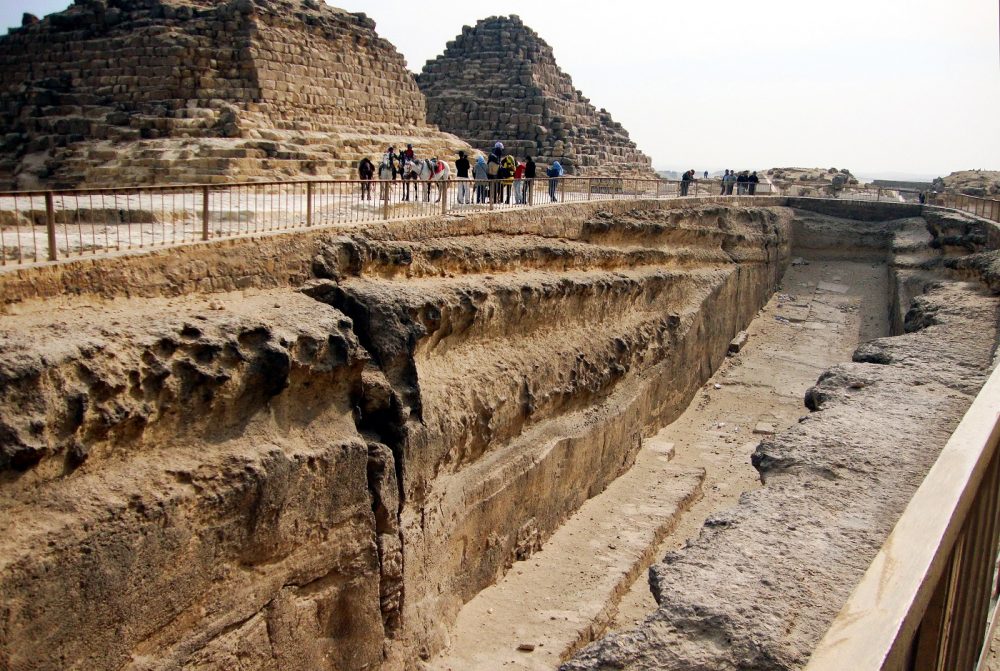
However, this Boat contains signs indicating that it was used in the water, and it is possible that the funerary Boat carried the embalmed body of the pharaoh from Memphis to Giza via the Nile, or that Khufu used it as a “pilgrimage ship” to visit holy places and be buried for use in the afterlife.
Khafre Solar ship
Egyptologists believe that King Khafre, the builder of the second-largest pyramid at Giza, had as many as six solar barges. Archeological excavations have revealed five pits where the boats were buried. One such pit is located along the eastern face of his pyramid.
As revealed by the Giza Project at Harvard University, “Six boat pits are in an area north and south of Khafre’s mortuary temple. Two are north and parallel to the temple; one is north and perpendicular to the temple, two are south and parallel to the temple; one is south and perpendicular to the temple along the east side of the pyramid.
Hor-Aha Solar ships
Not one but an entire collection of solar barges, and some of the oldest ever discovered in addition to that. Back in 1991, archaeologists excavating the desert not far from Abydos stumbled across fourteen solar barges that were later found to date back to the early first dynasty of ancient Egypt, and were likely associated with Hor-Aha.
This is a big deal, not only because of the age of the solar boats—dating back to 2950–2775 BC—but because Hor-Aha is considered one of the first Pharaohs to rule over Egypt.
Abydos was home to dozes of boast pits home to solar barges. The length of the ships varied from 20 to nearly 30 meters in length. These are also considered the world’s most ancient planked hulls.
Senusret III
Dahshur is home to some of the most important pyramids in Egypt; the Bent Pyramid and the Red Pyramid of Sneferu are both located at the royal necropolis of Dahshur. However, this region is home to many archaeological wonders.
Archaeological excavations of the site have revealed the existence of six solar barges near the pyramid of Senusret III—the fifth king of the Twelfth Dynasty of the Middle Kingdom.
One of the ships measured some 18 meters in length. Of the six solar barges, only the whereabouts of four are known.
Abu Gorab and the Niuserre solar barge
Abu Gorab is known for its revolutionary Solar Temple, located a few hundred meters from Abusir. At the southern side of the temple, archeological excavations discovered a large building that was shaped like a boat. The pit was lined with mud bricks that were at one point in history plastered, whitewashed, and painted in vivid colors.
Although no boat was discovered inside, the entire meaning of the structure, which, as augmented with several other elements, made it look like a solar barge, obviously, the meaning of the structure was purely symbolic in representing a solar boat. Nonetheless, archaeologists say that at one point in the distant past, the structure may have been home to an actual solar ba
Sources and references are embedded in the article itself.
Join the discussion and participate in awesome giveaways in our mobile Telegram group. Join Curiosmos on Telegram Today. t.me/Curiosmos



